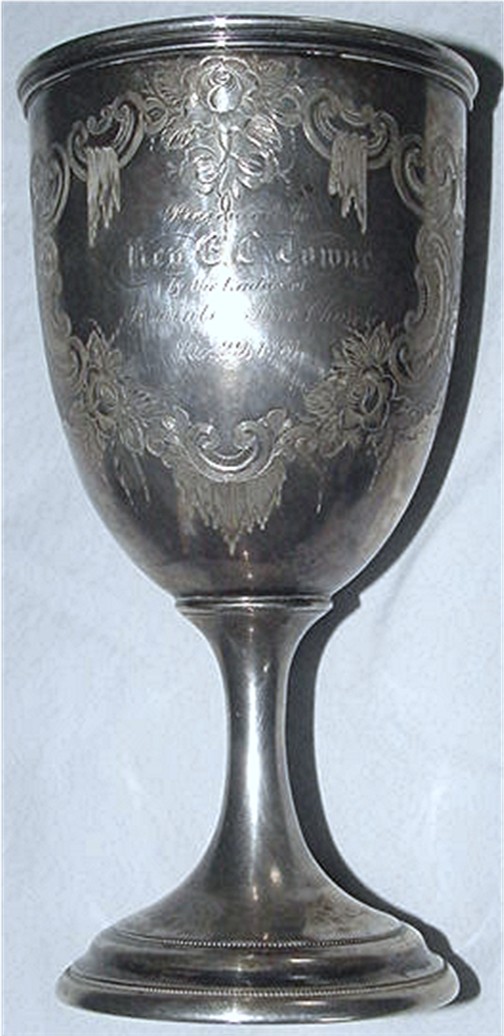|
COMMEMORATIVE SILVER GOBLET PRESENTED TO MASSACHUSETTS
REVEREND EDWARD CORNELIUS TOWNE IN MARCH OF 1861 –
GRADUATE OF YALE SEMINARY, UNITARIAN MINISTER AND STAFF
CONTRIBUTOR TO THE ENCYCLOPEDIA BRITANNICA – AN ARTIFACT
IDENTIFIED TO AN INTERESTING HISTORICAL MEMBER OF THE
CLERGY:
Occasionally a piece
surfaces that commemorates the day to day life that was
occurring at the time of great national crisis and
upheaval, capturing a moment when the citizenry kept
faith with their day to day concerns and observances in
spite of the chaos enveloping their lives. Presented to
a minister by the members of his small community church
on the eve of the American Civil War, this goblet is
just such a piece.
This silver plated goblet, hand engraved with an
intricate detailed floral pattern, bears the inscription
"Presented to Rev. E. C. Towne by the Ladies of
the Braintree Free Church, Mar. 29, 1861".
Rev. Towne recorded a very active life, leaving a
considerable biography which not only accounts for this
presentation, but recorded a lifetime of
accomplishments.

Rev. Towne, born in Massachusetts in 1834, joined the
sophomore class at Yale Theological Seminary in 1854 and
graduated in 1859. He was ordained on July 11, 1860 at
the Free Church of Braintree, Massachusetts, explaining
his relationship with that church which led to this
presentation. As noted in the 1912 edition of the
“Obituary Record of Yale Graduates”, Towne departed
Braintree in the spring of 1861 to become the pastor of
the First Parish (Unitarian) Church in Medford,
Massachusetts where he would remain for the following
seven years.
Apparently, the Ladies of Braintree Free Church
presented Rev. Towne with this goblet upon his departure
to commemorate his new position as pastor in Medford –
indicating the ladies group must have thought highly of
Towne.
Rev. Towne went on to develop a career in journalism.
As early as 1868 he was on the staff of the Chicago
Tribune and wrote for the Chicago Evening Journal until
the Great Fire in 1871. Over the next forty years,
while continuing to speak from the pulpits of churches
throughout the northeast, and for a period of five years
over in England, Towne also worked in a variety of
newspaper and editing positions, including publishing
several periodicals and monographs. Perhaps his most
notable position in the publishing world was serving on
the staff of the Encyclopedia Britannica as a
contributor, reviser, and index-maker. The Reverend
passed away in 1911 at the age of 77 in Brooklyn, New
York and is interred at Vine Hills Cemetery in Plymouth,
Massachusetts.
This goblet, measuring 6 ½” high and 3 ¼” in diameter at
the mouth, appears to be silver plated over a
non-ferrous base metal. All of the floral pattern
engraving and the engraved inscription are well executed
and have survived without any wear or damage. The
goblet retains it full form with only a minor cupping to
the bottom pedestal.
This is a nice commemorative piece from the life of a
noted mid-19TH Century American cleric and
author. (0937) $350
|

